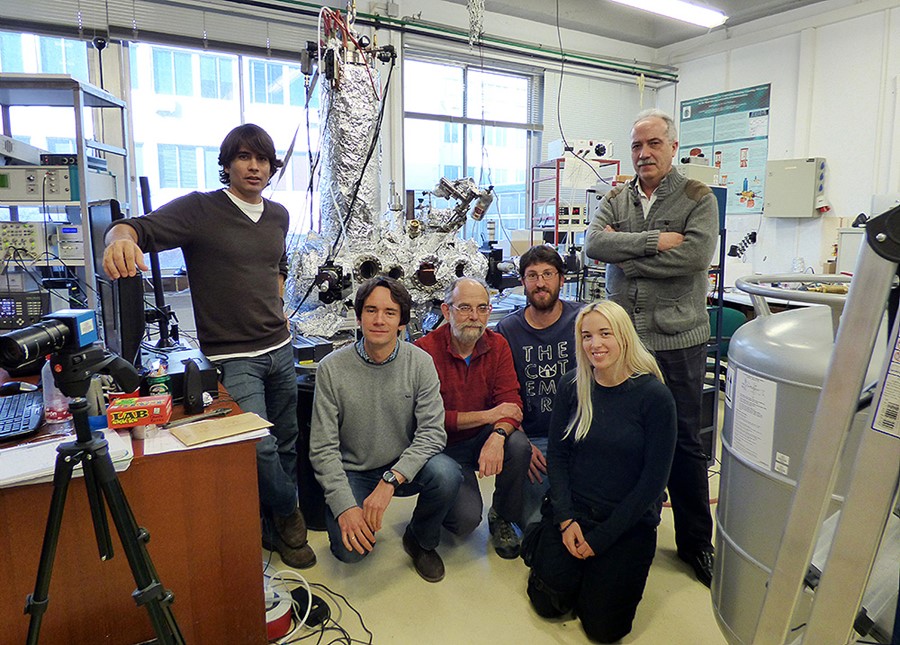Graphene has a range of outstanding mechanical and electronic properties, but no inherent magnetic properties. However, magnetism can be induced in graphene by the lightest element, hydrogen, which can transfer its magnetic moment to graphene. This has been demonstrated by a team of European scientists coordinated by the physicist Iván Brihuega from the Autonomous University of Madrid, Spain.
Since scientists completed their first experiments on isolated layers of graphene, laboratories across the globe have tried to include magnetism in the long list of properties of this two-dimensional material formed by carbon atoms.
Under the European Graphene Flagship initiative, three research groups from Spain, France and Germany have begun to demonstrate experimentally that graphene can be magnetized through the adsorption of individual hydrogen atoms.
The project, called HiMagGraphene, is coordinated by Iván Brihuega from the Department of Condensed Matter Physics at the Autonomous University of Madrid (UAM), Spain.
What happens when graphene and hydrogen bond?
The results obtained to date in our project reveal that if a hydrogen atom touches a layer of graphene, it transfers its magnetic moment. Unlike more common magnetic materials – such as iron, nickel and cobalt – which have magnetic moments of only a few tenths of a nanometre, the magnetic moment produced in graphene by each hydrogen atom extends several nanometres, which we can modulate on an atomic scale.
Exactly what happens during the process?
The magnetic moments produced in graphene interact strongly across large distances (in comparison with the atomic scale) following, moreover, a special rule: these moments build up or are neutralised depending on the relative position of the hydrogen atoms on the material. The structure of graphene, made up of carbon atoms arranged in a hexagonal shape, can be considered two triangular subnets, and if the hydrogen atoms are positioned on only one out of these two subnets, magnetic moments build up. However, they are cancelled out when one hydrogen atom is positioned on each subnet.
How do you move the hydrogen atoms?
Using a powerful scanning tunneling microscope, which we use to individually visualise and manipulate these atoms. In this way, we establish the magnetic properties of selected regions of the graphene. We carried out the experiments in the Institute of Condensed Matter Physics (IFIMAC) of UAM, and the results have been complemented with sophisticated theoretical calculations. We presented the details last year in the journal Science.
Have you published more papers related to the project?
In 2016, together with co-workers from the Basque Country, we published another study in ACS Nano in which we demonstrated how some properties of graphene vary when a metallic substrate is positioned beneath it. To be specific, the possibility of producing magnetic moments no longer exists. And in 2017, we published a study in The Journal of Physical Chemistry B, on the selective adsorption of hydrogen in rotated bilayers of graphene.
Which other groups are taking part in HiMagGraphene alongside you?
Two other groups. One is the Institut Néel in Grenoble (CNRS, France), which provides various types of graphene samples grown on silicon carbide. And the other is the German group from the Max-Planck-Institute (MPI) in Stuttgart, which has a unique infrastructure in scanning tunneling microscopy. We collaborate with them taking measurements at a very low temperature (below 1 Kelvin) and with high magnetic fields (up to 14 teslas).
From left to right: Iván Brihuega (project coordinator, PI of the group UAM), Dr Vladimir Cherkez (Institut Néel), Professor Jean-Yves Veuillen (PI Institut Néel), Dr Héctor González Herrero (UAM), Eva Cortés del Río (UAM), Professor José María Gómez-Rodríguez (UAM)
Which phase of the project are you currently in?
HiMagGraphene is a three-year project which ends in November 2018. We are currently studying how to manipulate hydrogen atoms on the surface of graphene on a very large scale and with atomic precision in order to selectively modify their properties. We are also investigating the evolution of the magnetic moment produced in this material by the hydrogen atoms (which we call a spin polarised state) and how it depends on the magnetic field applied and the temperature of the sample.
Is spintronics a potential application of magnetic graphene?
Graphene is an ideal material for use in spintronics, a promising technology which aims to substitute traditional electronic technology with simultaneously transmitting magnetic (through spin) and electronic information. This could give way to a radically new generation of computers. The results of our project, which prove the possibility of generating magnetic moments which can communicate across large distances in graphene, anticipate a brilliant future for this material, both in the emerging field of spintronics and for its use in flexible and biocompatible magnetic devices. Furthermore, the ability to manufacture magnetic graphene would give us magnetic plastics, textiles and even nanoparticles with potential healthcare applications.
---
SINC produces scientific news for the European project SCOPE, coordinated by FECYT and funded by the European Union through Horizon 2020, its funding program. The SCOPE mission is to communicate visionary research results of partnering projects in the framework of the Graphene Flagship and the Human Brain Project, as well as to enhance the FET Flagships partnering environment in the European Union.
This is an edited version of a piece produced by SINC which was first published on November 30 2017 under a Creative Commons Licence.




